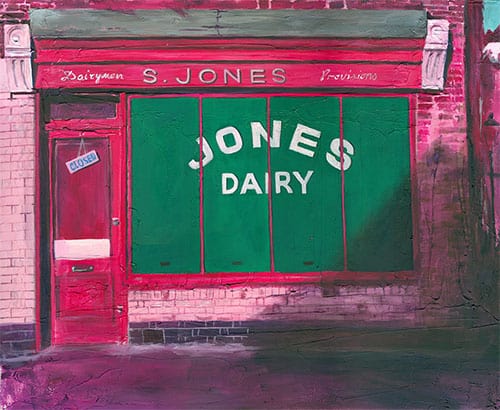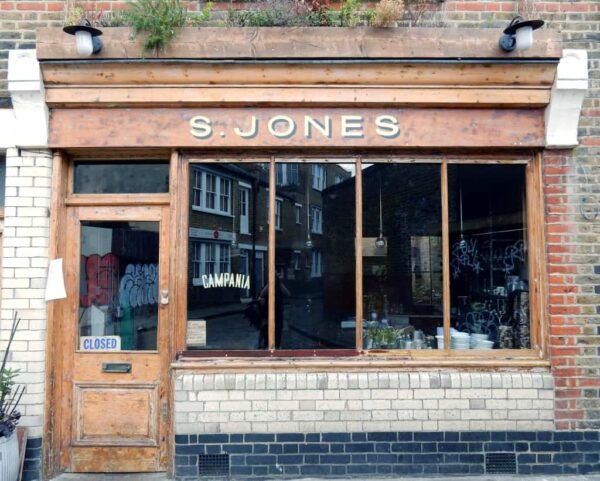20 Apr 2018
Michelle Heron’s Fantastic Fascias
Michelle Heron is a London-based painter with a paticular fascination for old shops and shop fronts. Her paintings depict iconic fascias, many of which have been lost since she turned her attention to them, and some that survive in a state of perpetual uncertainty. As with my own work on ghostsigns, Michelle is focused on capturing “the individuality and charm of these places before they are lost to modern development” and so I decided to ask her a bit more about her work.

Sam Roberts (SR): What first got you interested in shops, shop fronts and signs as a subject for your work?
Michelle Heron (MH): I think it started from when I used to be a window dresser, I never really noticed shop fronts before. That led to me constantly look at shop fronts and architecture. I wanted to capture local icons simply because of their distinctive typefaces and how much they stood out to me aesthetically. But now, almost everytime I take a photo or make a painting of a building within weeks it’s either being painted over or has closed down, even if it stood vacant for years like Zodiac Records in Wandsworth. Now, I like the idea that I’m immortilising these places in paint but at the same time I’m sad that the high street is changing so rapidly and not just in London. Will those stories continue when there’s just nail salons, vape shops and supermarket chains? But then again these old shops used to be different shops once before so I guess change is inevitable.

SR: How do you go about creating one of your pieces?
MH: I begin by taking photographs and if I’m not familiar with the area I’ll revisit it at different times before I catch the right light effect and to also get a feel for the place. It all builds up a picture in my mind and I think that it comes out emotionally in my painting. I like to create a bit of drama in the painting with shadows, I think the contrast of the light and dark adds an almost theatrical atmosphere to the empty buildings. When I go about London with my camera I have to plot where the sun will be positioned at a particular time in order to catch the right effect. Sometimes it will take me weeks to find the right composition due to the weather or if there are any parked cars, you need a lot of patience! I then spend several days or weeks working from that photograph using acrylic paint.

(My photo above shows the shop soon after it closed down in 2015. The fascia is Grade II listed and so should survive regardless of who moves in next.)
SR: Do you ever research historical aspects relating to the places you’re painting, or stories of the people that work there/own them?
MH: Yes, I think it’s important to know the context of them, it all adds to the final painting as I’m bringing my experience of the place I’m painting. I don’t think I could paint so many painstaking bricks if I wasn’t emotionally invested in what I’m looking at. There have been some instances when I’ve been able to contact the previous owners and donated one of my prints. I see it as my way of saying thank you for existing.


(My photo above shows this sign following its restoration by East End signwriter Peter Hardwicke.)
SR: Can you pinpoint what it is about the shops that you choose that makes you want to work with them?
MH: In the beginning it was from a purely aesthetic point if I loved a particular font/sign. Now it’s something more and it’s hard for me to describe. I find it can be a personal preference as sometimes I receive suggestions of places but if they don’t resonate with me then I don’t feel the urge to paint them. Usually though, it’s a combination of an old sign, striking font and an interesting history/story. Sometimes it’s hard to differentiate those shops with the ones that just look old because of the sun and pollution fading or weathering the facade.

SR: What’s your favourite London shopfront and why?
MH: I think my favourite is The Egg Stores in Stamford Hill because it was the first sign that I fell in love with. I just love that Stymie Bold Italic font and the retro colours. Plus it’s huge compared to most shop signs.

SR: How can people buy your work, commission you to paint their shop, or find you/keep in touch online.
MH: I can be found on most social media sites: Instagram; Twitter; Facebook; and my website.
Thank you Michelle for sharing your work and taking the time to answer the questions.


